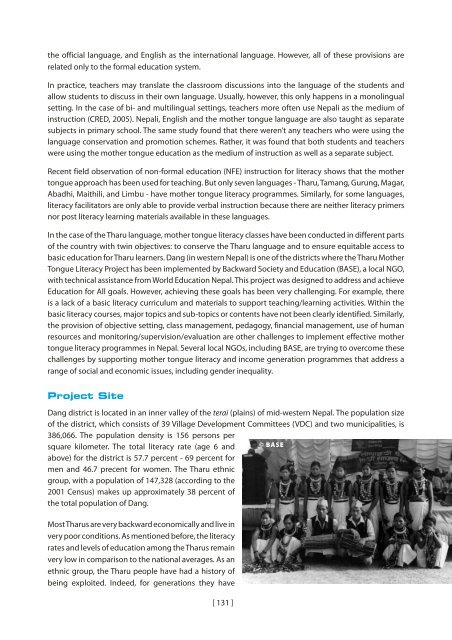Mother Tongue-based Literacy Programmes: Case Studies of Good ...
Mother Tongue-based Literacy Programmes: Case Studies of Good ...
Mother Tongue-based Literacy Programmes: Case Studies of Good ...
You also want an ePaper? Increase the reach of your titles
YUMPU automatically turns print PDFs into web optimized ePapers that Google loves.
the <strong>of</strong>ficial language, and English as the international language. However, all <strong>of</strong> these provisions arerelated only to the formal education system.In practice, teachers may translate the classroom discussions into the language <strong>of</strong> the students andallow students to discuss in their own language. Usually, however, this only happens in a monolingualsetting. In the case <strong>of</strong> bi- and multilingual settings, teachers more <strong>of</strong>ten use Nepali as the medium <strong>of</strong>instruction (CRED, 2005). Nepali, English and the mother tongue language are also taught as separatesubjects in primary school. The same study found that there weren’t any teachers who were using thelanguage conservation and promotion schemes. Rather, it was found that both students and teacherswere using the mother tongue education as the medium <strong>of</strong> instruction as well as a separate subject.Recent field observation <strong>of</strong> non-formal education (NFE) instruction for literacy shows that the mothertongue approach has been used for teaching. But only seven languages - Tharu, Tamang, Gurung, Magar,Abadhi, Maithili, and Limbu - have mother tongue literacy programmes. Similarly, for some languages,literacy facilitators are only able to provide verbal instruction because there are neither literacy primersnor post literacy learning materials available in these languages.In the case <strong>of</strong> the Tharu language, mother tongue literacy classes have been conducted in different parts<strong>of</strong> the country with twin objectives: to conserve the Tharu language and to ensure equitable access tobasic education for Tharu learners. Dang (in western Nepal) is one <strong>of</strong> the districts where the Tharu <strong>Mother</strong><strong>Tongue</strong> <strong>Literacy</strong> Project has been implemented by Backward Society and Education (BASE), a local NGO,with technical assistance from World Education Nepal. This project was designed to address and achieveEducation for All goals. However, achieving these goals has been very challenging. For example, thereis a lack <strong>of</strong> a basic literacy curriculum and materials to support teaching/learning activities. Within thebasic literacy courses, major topics and sub-topics or contents have not been clearly identified. Similarly,the provision <strong>of</strong> objective setting, class management, pedagogy, financial management, use <strong>of</strong> humanresources and monitoring/supervision/evaluation are other challenges to implement effective mothertongue literacy programmes in Nepal. Several local NGOs, including BASE, are trying to overcome thesechallenges by supporting mother tongue literacy and income generation programmes that address arange <strong>of</strong> social and economic issues, including gender inequality.Project SiteDang district is located in an inner valley <strong>of</strong> the terai (plains) <strong>of</strong> mid-western Nepal. The population size<strong>of</strong> the district, which consists <strong>of</strong> 39 Village Development Committees (VDC) and two municipalities, is386,066. The population density is 156 persons persquare kilometer. The total literacy rate (age 6 and © BASEabove) for the district is 57.7 percent - 69 percent formen and 46.7 precent for women. The Tharu ethnicgroup, with a population <strong>of</strong> 147,328 (according to the2001 Census) makes up approximately 38 percent <strong>of</strong>the total population <strong>of</strong> Dang.Most Tharus are very backward economically and live invery poor conditions. As mentioned before, the literacyrates and levels <strong>of</strong> education among the Tharus remainvery low in comparison to the national averages. As anethnic group, the Tharu people have had a history <strong>of</strong>being exploited. Indeed, for generations they have[ 131 ]

















